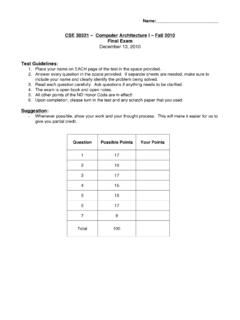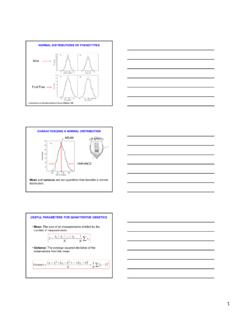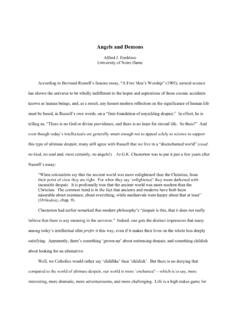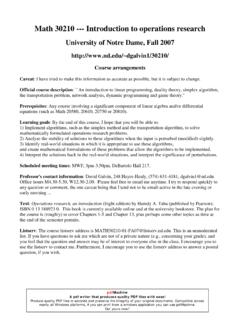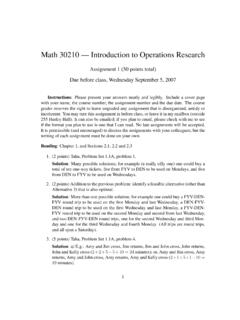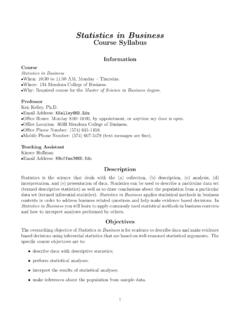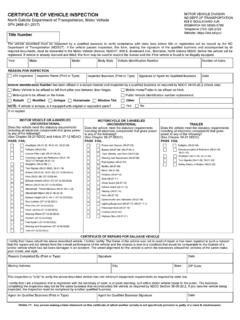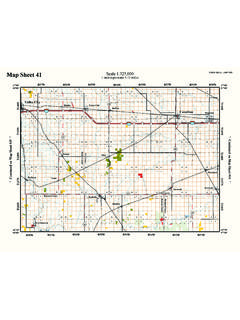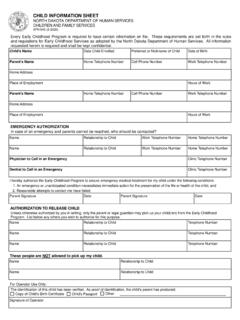Transcription of The Binomial Distribution - University of Notre Dame
1 The Binomial Distribution A. It would be very tedious if, every time we had a slightly different problem, we had to determine the probability distributions from scratch. Luckily, there are enough similarities between certain types, or families, of experiments, to make it possible to develop formulas representing their general characteristics. For example, many experiments share the common element that their outcomes can be classified into one of two events, a coin can come up heads or tails; a child can be male or female; a person can die or not die; a person can be employed or unemployed. These outcomes are often labeled as success or failure.
2 Note that there is no connotation of goodness here - for example, when looking at births, the statistician might label the birth of a boy as a success and the birth of a girl as a failure, but the parents wouldn't necessarily see things that way. The usual notation is p = probability of success, q = probability of failure = 1 - p. Note that p + q = 1. In statistical terms, A Bernoulli trial is each repetition of an experiment involving only 2 outcomes. We are often interested in the result of independent, repeated bernoulli trials, the number of successes in repeated trials. 1. independent - the result of one trial does not affect the result of another trial.
3 2. repeated - conditions are the same for each trial, p and q remain constant across trials. Hayes refers to this as a stationary process. If p and q can change from trial to trial, the process is nonstationary. The term identically distributed is also often used. B. A Binomial Distribution gives us the probabilities associated with independent, repeated Bernoulli trials. In a Binomial Distribution the probabilities of interest are those of receiving a certain number of successes, r, in n independent trials each having only two possible outcomes and the same probability, p, of success. So, for example, using a Binomial Distribution , we can determine the probability of getting 4 heads in 10 coin tosses.
4 How does the Binomial Distribution do this? Basically, a two part process is involved. First, we have to determine the probability of one possible way the event can occur, and then determine the number of different ways the event can occur. That is, P(Event) = (Number of ways event can occur) * P(One occurrence). Suppose, for example, we want to find the probability of getting 4 heads in 10 tosses. In this case, we'll call getting a heads a success. Also, in this case, n = 10, the number of successes is r = 4, and the number of failures (tails) is n r = 10 4 = 6. One way this can occur is if the first 4 tosses are heads and the last 6 are tails, The Binomial Distribution - Page 1.
5 SSSSFFFFFF. The likelihood of this occurring is P(S) * P(S) * P(S) * P(S) * P(F) * P(F) * P(F) * P(F) * P(F) * P(F). More generally, if p = probability of success and q = 1 p = probability of failure, the probability of a specific sequence of outcomes where there are r successes and n-r failures is p r q n r So, in this particular case, p = q = .5, r = 4, n-r = 6, so the probability of 4 straight heads followed by 6 straight tails is . = (or 1 out of 1024). Of course, this is just one of many ways that you can get 4 heads; further, because the repeated trials are all independent and identically distributed, each way of getting 4 heads is equally likely, the sequence S S S S F F F F F F is just as likely as the sequence S F S F F S F F S F.
6 So, we also need to know how many different combinations produce 4 heads. Well, we could just write them all out but life will be much simpler if we take advantage of two counting rules: 1. The number of different ways that N distinct things may be arranged in order is N! = (1)(2)(3)..(N-1)(N), (where 0! = 1). An arrangement in order is called a permutation, so that the total number of permutations of N objects is N!. The symbol N! is called N factorial. EXAMPLE. Rank candidates A, B, and C in order. The possible permutations are: ABC ACB BAC BCA CBA CAB. Hence, there are 6 possible orderings. Note that 3! =. (1)(2)(3) = 6. NOTE: Appendix E, Table 6, p.
7 19 contains a Table of the factorials for the integers 1. through 50. For example, 12! = * 108. (Or see Hayes Table 8, p. 947). Your calculator may have a factorial function labeled something like x! 2. The total number of ways of selecting r distinct combinations of N objects, irrespective of order, is N! N N . = = . r! (N - r)! r N r . We refer to this as N choose r. Sometimes the number of combinations is known as a Binomial coefficient, and sometimes the notation NCr is used. So, in the present example, The Binomial Distribution - Page 2. N 10 N! 10! 10 * 9 * 8 * 7 5040. = = = = = = 210. r 4 r! (N - r)! 4! ( 10 4 )! 4 * 3 * 2 *1 24. Note that, for 10!
8 , I stopped once I got to 7; and I didn't write out 6! in the denominator. This is because both numerator and denominator have 6! in them, so they cancel out. So, there are 210. ways you can toss a coin 10 times and get 4 heads. EXAMPLE. Candidates A, B, C and D are running for office. Vote for two. The possible choices are: AB AC AD BC BD CD, there are 6 possible combinations. Confirming this with the above formula, we get N! 4 4! (4)(3)(2)(1) 12. = = = = =6. r! (N - r)! 2 2! (4 - 2)! (2)(1)(2)(1) 2. EXAMPLE. There are 100 applicants for 3 job openings. The number of possible combinations is N! 100 100! 100 * 99 * 98 970,200. = = = = = 161,700.
9 R! (N - r)! 3 3!97! 3* 2 6. Again, note that, if you didn't take advantage of 97! appearing on both top and bottom, you'd have a much lengthier calculation. See Appendix E, Table 7, page 20 for NCr values for various values of N and r. (Or see Hayes, Appendix E, Table IX, p. 948). Your calculator may have a function labeled nCr or something similar. C. So putting everything together now: we know that any specific sequence that produces 4. heads in 10 tosses has a probability of Further, we now know that there are 210. such sequences. Ergo, the probability of 4 heads in 10 tosses is 210 * =. We can now write out the complete formula for the Binomial Distribution : In sampling from a stationary Bernoulli process, with the probability of success equal to p, the probability of observing exactly r successes in N independent trials is N r N -r N!
10 P q = r N -r p q r r! (N - r)! Once again, N choose r tells you the number of sequences that will produce r successes in N. tries, while prqN-r tells you what the probability of each individual sequence is. The Binomial Distribution - Page 3. To put it another way, the random variable X in a Binomial Distribution can be defined as follows: Let Xi = 1 if the ith bernoulli trial is successful, 0 otherwise. Then, X = Xi, where the Xi's are independent and identically distributed (iid). That is, X = the # of successes. Hence, Any random variable X with probability function given by N N! p(X = r; N, p) = p r q N -r = r N -r p q , X = 0, 1, 2, .., N.

